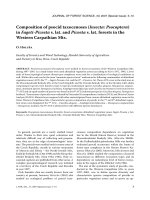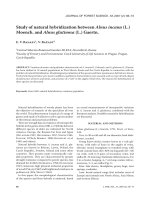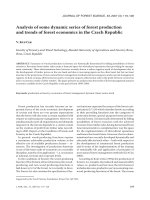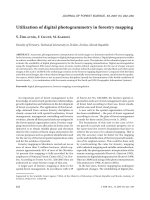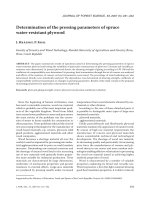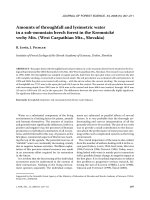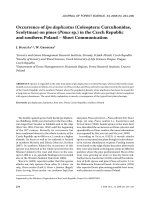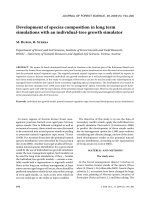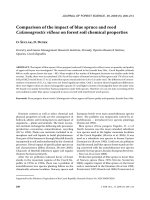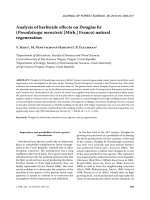Báo cáo lâm nghiệp: "Diversity of endomycorrhizal fungi and their synergistic effect on the growth of Acacia catechu Willd." pot
Bạn đang xem bản rút gọn của tài liệu. Xem và tải ngay bản đầy đủ của tài liệu tại đây (198.99 KB, 8 trang )
J. FOR. SCI., 55, 2009 (10): 461–468 461
JOURNAL OF FOREST SCIENCE, 55, 2009 (10): 461–468
Acacia catechu Willd. is an medicinally important
leguminous tree that grows naturally in all kinds of
geological formations and soils of all kinds. Katha,
which is an important ingredient in the “Pan”
preparation commonly used in northern India, is
commercially obtained from this plant. A. catechu
has better microflora in its rhizosphere. e arbus-
cular mycorrhizal (AM) fungi take an important
ecological position amongst various microorganisms
colonizing the rhizosphere of plants. e occurrence
of endomycorrhizal fungi (AM) in soil, their asso-
ciation with both forestation and agricultural crops
are well documented (R et al. 1999; G, S
2002). Inoculation with a suitable AM fungal strain
to improve the growth and survival of plant seed-
lings in forestation is very essential. e role of AM
fungi in improving the quality and survival of plant
seedlings after plantation has been well recognized
(K et al. 1992; K, U 1999; O
2003; B et al. 2007). e mutual relation-
ship between mycorrhizal fungi and host plants has
been studied in terms of the benefits to individual
plants and fungi (F, R 1995; S,
S 1996). e effect of mycorrhizal fungi on
nutrient uptake and plant growth has been exten-
sively studied (T, B 1997; W-
et al. 1999; L et al. 2000; A-H,
A-M 2006). Mycorrhizal infection has a
particular value for legumes because nodulation and
symbiotic nitrogen fixation by Rhizobia require an
adequate phosphorus supply and a restricted root
system leads to poor competition for soil phospho-
rus (C et al. 1978).
Various researchers have made efforts to increase
the quality of seedlings of forest trees through the
inoculation of a suitable mycorrhizal strain alone
Diversity of endomycorrhizal fungi and their synergistic
effect on the growth of Acacia catechu Willd.
V. P
1
, A. A
2
1
Rain Forest Research Institute (ICFRE), Assam, India
2
Botany Department, Kurukshetra University, Haryana, India
ABSTRACT: e diversity of arbuscular mycorrhizal (AM) fungi of Acacia catechu Willd. was studied. Dominant AM
spores, the bacterium Rhizobium sp. along with the fungus Trichoderma viride were isolated from the rhizosphere of
A. catechu
and mass-produced in laboratory. e co-inoculation effect of Glomus mosseae, Glomus fasciculatum, mixed
AM (Glomus spp. [except G. mosseae, G. fasciculatum] with Acaulospora spp., Sclerocystis spp. and Gigaspora spp.),
Rhizobium sp. and Trichoderma viride was studied as exerted on the growth of A. catechu seedlings. All inoculated
seedlings showed improved seedling growth compared to the control. Inoculated seedlings had a pronounced effect
on all growth parameters such as height, fresh and dry weight of roots and shoots, AM spore count, per cent mycor-
rhizal colonization in roots and root nodule number in comparison with uninoculated seedlings. Phosphorus uptake
was also higher in inoculated seedlings than in the control. is study provides a good scope for commercially utiliz-
ing the efficient strains of AM fungi for beneficial effects with other beneficial rhizosphere microflora in the primary
establishment of slow growing seedlings ensuring better survival and improved growth.
Keywords: Acacia catechu Willd.; co-inoculation; phosphorus; Rhizobium sp.; Trichoderma viride; AM diversity
Abbreviations: ppm – parts per million, LSD – least standard deviation, sp. – species, AM – arbuscular mycorrhiza
462 J. FOR. SCI., 55, 2009 (10): 461–468
Table 1. Growth response of Acacia catechu to double inoculation after 90 days
S.
No.
Treatment (double inoculation)
Increase in
height (cm)
Root length
(cm)
Fresh shoot
wt. (g)
Dry shoot
wt. (g)
Fresh root
wt. (g)
Dry root
wt. (g)
VAM spore
number/50 g
soil
Mycorrhizal
colonization
in roots (%)
Presence of
nodules
1 Control *1.5 ± 0.03 13.0 ± 0.70 6.8 ± 0.01 5.73 ± 0.02 8.4 ± 0.34 6.62 ± 0.36 39 ± 0.70 56.66 ± 2.72 _
2 Mixed AM + Rhizobium sp. 22.0 ± 1.06 21.0 ± 0.70 7.9 ± 0.03 6.37 ± 0.02 10.6 ± 0.69 7.65 ± 0.26 113 ± 2.82 93.33 ± 5.44 ++
3 G. mosseae + Rhizobium sp. 22.2 ± 1.41 22.5 ± 1.76 10.3 ± 0.36 7.89 ± 0.23 14.3 ± 0.40 10.09 ± 5.65 120 ± 2.12 93.33 ± 4.61 +++
4 G. fasciculatum + Rhizobium sp. 8.25 ± 0.35 20.0 ± 1.41 7.7 ± 0.47 6.20 ± 0.35 8.8 ± 1.08 6.56 ± 0.47 102 ± 0.70 80.55 ± 2.26 +
5 Trichoderma viride + Rhizobium sp. 4.0 ± 0.35 17.5 ± 5.30 7.2 ± 0.42 6.01 ± 0.15 8.5 ± 0.61 6.81 ± 0.13 101 ± 1.41 76.66 ± 2.72 –
*Mean of five replications each, ± standard error, +++ abundant, ++ moderate, + low, – absent
Source of variation Degree of freedom Sum of squares Mean of squares F obtained (F ratio) F crit. (table)
Between 4 441 110.25 15.7* 0.05 P = 5.19
Within 5 32 6.4 0.01 P = 11.3
Total 9 473
*According to the analysis of variance (ANOVA) of data, the calculated F ratio is 15.7, which is significant at 0.01% P level (F crit. 0.01 = 5.19, 0.05 = 11.39)
J. FOR. SCI., 55, 2009 (10): 461–468 463
or AM-Rhizobium sp. combinations in nursery
conditions (A, R 1990; B
et al. 1990; C 1990; R, B
1990; L, H 1991; T et
al. 1992; S, T 1997; R et al. 1999; K-
et al. 2002; P et al. 2005; K, Z
2007). But very little or hardly any work has been
done to improve and produce the quality seedlings
of A. catechu by using the triple co-inoculation of
VAM strains since this plant is economically more
important on a local level and slow growing as well.
Bearing this in mind, the present study was under-
taken to determine the effect of double and triple
inoculation (co-inoculation) of AM fungi with other
rhizospheric microflora on the growth performance
of A. catechu.
MATERIALS AND METHODS
e native predominant AM fungi, i.e. Glomus
mosseae and Glomus fasciculatum, were isolated
from the rhizosphere of A. catechu. All the remaining
species of Glomus (except G. mosseae, G. fascicula-
tum), Acaulospora, Sclerocystis and Gigaspora were
also isolated and mixed together to prepare a mixed
AM inoculum. Rhizobium sp. and Trichoderma
viride were also isolated from the rhizosphere of
A. catechu in a similar way. All mycorrhizal inocula
(Glomus mosseae, Glomus fasciculatum, Mixed
AM) were mass-produced on maize (Zea mays L.).
Rhizobium sp. inoculum was mass-cultured on yeast
extract mannitol agar (YEMA) medium. T. viride was
also mass-produced on wheat bran:saw dust:water
(3:1:4) medium for further inoculation experiments.
Seedlings of A. catechu were procured from Divi-
sional Forest Nursery, Hamirpur Forest Department,
Himachal Pradesh, India.
Inoculation: Inoculation experiments were de-
signed in double and triple combinations (co-inocu-
lation). In double inoculation, mixed AM (except
G. mosseae
and G. fasciculatum), G. mosseae, G. fas-
ciculatum and Trichoderma viride were mixed with
Rhizobium species only while in triple inoculation,
mixed AM (except G. mosseae and G. fasciculatum),
G. mosseae and G. fasciculatum were mixed together
with T. viride and Rhizobium species. All inocula-
tion experiments were performed in sterilized soils.
Two seedlings of A. catechu were grown in each ex-
perimental earthen pot (30 × 30 cm) in a sandy soil
mixture (300:1,500 g). To each pot 10% of the fungal
(T. viride), bacterial (Rhizobium sp.) and mycor-
rhizal inocula along with infected roots were added
around the rhizosphere. Only five replications were
prepared. In control sets, no inoculum was added.
After 45 and 90 days interval observations were re-
corded on seedling shoot length (increase in height),
root length, shoot and root fresh and dry weight,
percentage mycorrhizal colonization in roots, AM
spore number, root nodule number and phosphorus
content (%) of seedlings. But only the observations
after 90 days are cited in this paper. Percentage
mycorrhizal colonization in roots was studied
(P, H 1970). e AM spore quanti-
fication was determined (G, N
1963). Phosphorus content (%) of shoots and roots
was determined by vanadomolybdate phosphoric
yellow colour method (J 1973). Data were
compared with the control after treatment. e data
were analyzed statistically by the analysis of variance
(ANOVA) (P 2000).
RESULTS AND DISCUSSION
Four genera of VAM fungi, e.g. Glomus, Acau-
lospora, Gigaspora and Sclerocystis, have been
reported from the rhizosphere of A. catechu.
Entrophospora and Scutellospora were found absent
in the rhizosphere. Glomus spp. were present in
abundance compared to the other genera. e per-
centage mycorrhizal colonization in roots was
(90 ± 7.07) and VAM spore number was (182.5 ± 5.30)
in 50 g of soil (five random replications). Both arbus-
cular and vesicular types of colonization were found
in roots of A. catechu. e AM fungi present in the
rhizosphere of A. catechu were Glomus mosseae,
G. fasciculatum, G. intraradices, G. macrocarpum,
Acaulospora laevis, A. foveata, Gigaspora sp., Scle-
rocystis coremioides.
Double inoculation: e effect of double inocu-
lation after 90 days on Acacia catechu is shown in
Table 1. It was revealed that the
G. mosseae + Rhi-
zobium sp. combination showed a maximum sig-
nificant (F
ratio
15.7, P > 0.05) increase in height
(22.2 ± 1.41) compared to the other treatments. AM
spore numbers, percentage mycorrhizal coloniza-
tion in roots, increase in plant height, fresh and dry
weights (shoot and root) were increased with the
time period when compared with earlier data of
45 days. e presence of nodules was also high in
G. mosseae and Rhizobium sp. treatment (Table 1).
No nodule was present either in the control or in
Trichoderma viride + Rhizobium sp. treatments.
Triple inoculation: e response of A. catechu
to triple inoculation after 90 days is shown in Table
2. It is evident from the table that the G. mosseae +
Rhizobium sp. + Trichoderma viride (triple inocu-
lum) combination showed a maximum significant
(F
ratio
48.0, P > 0.05) increase in height, root length,
464 J. FOR. SCI., 55, 2009 (10): 461–468
Table 2. Growth response of Acacia catechu to triple inoculation after 90 days
S.
No.
Treatment (triple inoculation)
Increase in
height (cm)
Root length
(cm)
Fresh shoot
wt. (g)
Dry shoot
wt. (g)
Fresh root
wt. (g)
Dry root
wt. (g)
VAM spore
number/50 g
soil
Mycorrhizal
colonization
in roots (%)
Presence
of nodules
1 Control *1.5 ± 0.03 13.0 ± 0.70 6.8 ± 0.01 5.73 ± 0.02 8.4 ± 0.34 6.62 ± 0.36 39 ± 0.70 56.66 ± 2.72 _
2
Mixed AM + Rhizobium sp.+
Trichoderma viride
11.2 ± 0.70 24.0 ± 5.65 9.9 ± 1.14 7.61 ± 0.74 13.7 ± 2.03 9.65 ± 0.95 118 ± 3.53 80.0 ± 4.71 ++
3
G. mosseae + Rhizobium sp. +
Trichoderma viride
22.2 ± 0.03 31.0 ± 6.36 10.6 ± 0.95 7.85 ± 0.53 20.5 ± 3.39 13.08 ± 2.09 126.5 ± 4.59 100.0 ± 0 +++
4
G. fasciculatum + Rhizobium sp. +
Trichoderma viride
5.88 ± 1.41 19.0 ± 0.70 7.8 ± 0.35 6.37 ± 0.20 10.4 ± 5.65 7.82 ± 0.01 95 ± 3.53 83.33 ± 2.72 +
*Mean of five replications each, ± standard error, ++ moderate, +++ abundant, + low, – absent
Source of variation Degree of freedom Sum of squares Mean of squares F obtained (F ratio) F crit. (table)
Between 3 288 96 48.0* 0.05 P = 3.11
Within 4 8 2 0.01 P = 5.06
Total 7 295
*According to the analysis of variance (ANOVA) of data, the calculated F ratio is 48.0, which is significant at 0.01% P level (F crit. 0.01 = 6.59, 0.05 = 16.69)
J. FOR. SCI., 55, 2009 (10): 461–468 465
fresh and dry weights of shoot and root, AM spore
number and percentage mycorrhizal colonization
in roots after 90 days in comparison with the other
inoculated treatments and control in which all these
above-mentioned growth parameters were low. In
this case, the G. mosseae + Rhizobium sp. + Tri-
choderma viride treatment also had more nodules
than the other treatments. Nodules were absent in
the control.
Double inoculation of mixed AM + Rhizobium
sp. also showed a higher P content (%) in shoots
(0.48 ± 0.01) and roots (0.99 ± 0.01) than the other
treatments as well as the control (Table 3) whereas
the triple inoculation of mixed VAM + Rhizobium
sp. + Trichoderma viride showed a higher P content
of roots (0.99 ± 0.01) than all the other treatments
and control. P content of shoots (0.48 ± 0.01) was
higher in all treatments than in the control and it
was also equal to the G. mosseae + Rhizobium sp.
+ Trichoderma viride treatment (0.48 ± 0.01). It is
evident from the results that all the inoculations had
a higher P content of shoots and roots than the con
-
trol. P content of roots was higher than P content of
shoots in all the inoculated seedlings of A. catechu.
ere are many reports that suggest the impor-
tance of VAM fungi in producing quality seedlings.
Recently, papers were published in which the
positive growth effect and nutrient uptake by plants
through AM inoculation was seen under different
water regimes and bioremediated and agricultural
soils (A-H, A-M 2006; A
Z et al. 2009). J et al. (2007) studied
the effect of AM inoculation on the drought resist-
ance of wild jujube (Ziziphus spinosus Hu) seedlings.
ey found that arbuscular mycorrhizal fungi helped
withstand the water stress and also improved the
growth of the seedlings.
In the present study, a soil-based inoculum was
used for all the experiments. Hence, the better
growth responses were seen in A. catechu. This
might be due to higher reproduction of AM fungi
present in the soil-based inoculum, which sprouted
rapidly from extracellular and intracellular hyphae
present in the soil and root inoculum. Co-inocula-
tion has a synergistic effect on seedlings through
increasing the efficiency of the shoot and root system
in providing the plant with essential levels of P and N
for growth. Inoculated seedlings with the entire test
AM fungi increased the phosphorus content of roots
and shoots as compared to the control in this study.
e increased rate of phosphorus uptake and inflow
in roots has been regarded as the major contribution
of AM infection (M 1973). Present findings also
indicated that mycorrhizal co-inoculated seedlings
Table 3. Effect of co-inoculation on the phosphorus content of Acacia catechu
S. No. Treatment
Phosphorus content (%) (ppm)
*shoot *root
Double inoculation
1 Mixed AM + Rhizobium sp. 0.48
a
± 0.01 0.99
d
± 0.01
2 G. mosseae + Rhizobium sp. 0.46
a
± 0.02 0.91
d
± 0
3 G. fasciculatum + Rhizobium sp. 0.44
a
± 0 0.79
c
± 0.01
4 Trichoderma viride + Rhizobium sp. 0.43
a
± 0.02 0.61
b
± 0.01
5 Control 0.41
a
± 0 0.43
a
± 0
LSD 0.37 0.12
Triple inoculation
1 Mixed AM + Rhizobium sp. + Trichoderma viride 0.48
a
± 0.01 0.99
b
± 0.01
2 G. mosseae + Rhizobium sp. + Trichoderma viride 0.48
a
± 0 0.89
b
± 0.021
3 G. fasciculatum + Rhizobium sp. + Trichoderma viride 0.46
a
± 0.023 0.88
b
± 0.010
4 Control 0.41
a
± 0 0.43
a
± 0
LSD 0.25 0.13
*Average of five replications each, means followed by the same superscript letter in columns are not significant at 0.05 P level,
± standard error of mean
466 J. FOR. SCI., 55, 2009 (10): 461–468
had a higher phosphorus content than the control
and similar results were also reported (K et
al. 2002) on chickpea. Z-Y et al. (1997)
observed that nodulation and plant growth were af-
fected by the degree of mycorrhization, i.e. both were
increased at higher levels. Interactions between the
host and symbiont also varied with cultivars. K
et al. (2002) concluded that mycorrhiza or Azoto-
bacter or Rhizobium alone or their combinations
could have an important effect on nodulation and
nitrogen fixation in legumes. e principal effect of
mycorrhiza on nodulation is P-mediated. e com-
bined inoculations of symbionts showed significantly
increased N-fixations growth and nutrient uptake in
Leucaena leucocephala and Cajanus cajan (S
et al. 1992).
e mutual association accounted for better colo-
nization and plant growth due to the interchange of
carbon, phosphate and nitrogen between the host
fungi and bacteria. According to B-E-D and
M (1998), the dual inoculation of AM and
Rhizobium had a synergistic effect on nodulation,
plant growth, dry matter production and nitrogen
fixation. Increased N-fixation due to increased
mycorrhizal colonization in roots and nodulation
may contribute to the growth and yield of plants
(G, S 2002). J et al. (2001)
reported that the growth of plants was enhanced
by mycorrhizal infection by increasing nutrient
uptake via an increase in the absorbing surface
area of roots. Similar results were also obtained on
wheat with plant growth promoting rhizobacteria
‘PGPR’ (K, Z 2007). D and T
(1994) also observed similar results while using the
soil-based AM inoculum. ey reported that the
spore population was maximum in soil root based
inoculum followed by AM spores inoculum. Re-
cognition of the complexity of interactions among
microbes in the rhizosphere has led to dual or
co-inoculation of crops with both AM fungi and
other rhizosphere microorganisms. By virtue of
their interdependent and synergistic effects on P
and N uptake, interactions between AM fungi and
symbiotic N
2
-fixing bacteria are important when
considering co-inoculations (G et al. 1985;
R et al. 1986). Nodulation has been shown to
be sometimes dependent on colonization by VAM
fungi (A-A, B 1978). Similarly,
inoculations with selected plant growth promoting
rhizosphere bacteria have demonstrated synergistic
benefits to the host when co-inoculated with VAM
fungi. In many cases, colonization in the roots by
AM fungi was increased by the other inoculants
(A-A, B 1978; A et al. 1989).
It has also been reported in this study that the ef-
fect of AM fungi is increased when they were co-
inoculated with other rhizosphere microflora like
Rhizobium sp. and Trichoderma viride.
CONCLUSION
All double and triple inoculation (co-inoculation)
treatments have a significant marked effect on the
growth of A. catechu seedlings compared to the
control sets in which a very small growth effect was
observed. In double inoculation, the G. mosseae +
Rhizobium sp. combination had a higher growth
effect than the other treatments. In triple inocula-
tion, G. mosseae + Rhizobium sp. + Trichoderma
viride had a higher growth effect than the other
treatments on A. catechu seedlings. is is due to
the mutual positive action of Rhizobium sp. and AM
fungi strains that helped in uptake of P and N from
soil. On the other hand, Trichoderma viride being
a biocontrol agent helped to control all pathogenic
fungal attack in the rhizosphere of A. catechu. On the
basis of the results it can be concluded that the co-
inoculation of Rhizobium sp. and Trichoderma viride
with efficient strains of AM fungi should be used in
practice to produce improved seedlings of A. catechu
ensuring better survival and improved growth dur-
ing adverse conditions in outplanted seedlings.
Acknowledgements
Financial support from the Council of Scientific
and Industrial Research, New Delhi, India, rendered
to Vipin Parkash is duly acknowledged.
R efe re nce s
ABDEL-HANEJ A.A.A., ABDEL-MONSIEF R.A., 2006. Effect
of VAM inoculation on growth, yield and nutrient content
of Cantaloup and Cucumber under different water regimes.
Research Journal of Agriculture and Biological Sciences,
2: 503–508.
AL-ZALZALEH H.A., AL-ZALZALEH M.A., MATHEW
A.R., 2009. VAM inoculation for selected ornamental plants
in bioremediated and agricultural soils. European Journal
of Scientific Research, 25: 559–556.
AMES R.N., REID C.P.P., PORTER K.K., CAMBARDELLA C.,
1989. Hyphal uptake and transport of nitrogen from two
15
N
leveled source by Glomus mosseae arbuscular mycorrhizal
fungus. New Phytologist, 95: 381–396.
AZCON R., RUBIO R., 1990. Interactions between different
VA-mycorrhizal fungi and Rhizobium strains on growth
and nutrition of Medicago sativa. Agriculture Ecosystem
and Environment, 29: 5–9.
J. FOR. SCI., 55, 2009 (10): 461–468 467
AZCON-AGUILAR C., BAREA J.M., 1978. Effects of interac-
tion between different culture fractions of phosphobacteria
and Rhizobium on mycorrhizal infection, growth and
nodulation of Medicago sativa. Canadian Journal of Botany,
24: 520–524.
BADER-EL-DIN S.M.S., MOAWAD H., 1998. Enhancement
of nitrogen fixation in lentil, fababean, and soybean by dual
inoculation with rhizobia and mycorrhizae. Plant and Soil,
108: 117–123.
BETHLENFALVAY G.J., BROWN M.S., FRANSON R.L.,
1990. Glycine – Glomus – Bradyrhizobium symbiosis. Plant
Physiology, 94: 723–726.
BOUREIMA S., DIOEF M., DIOEF T.A., DIETTA M., LEYE
E.M., NDIAYE F., SECK D., 2007. Effects of AM inocula-
tion on the growth and development of sessame (Sesamum
indicum L.). African Journal of Agricultural Research, 3:
234–238.
CARLING D.E., RICHLE N.E., JOHNSON D.R., 1978. Effect
of VAM on nitrate reductase and nitrogenase activity in
nodulation and non-nodulating soybean. Phytopathology,
68: 1590–1596.
CHAMPAWAT R.S., 1990. Response of chickpea (Cicer
arietinum) to Rhizobium and vesicular-arbuscular mycor-
rhizal dual inoculation. Acta Microbiologica Polonica, 39:
163–169.
DODD J.C., THOMPSON B.D., 1994. e screening and
selection of inoculant arbuscular mycorrhizal and ecto-
mycorrhizal fungi. In: ROBSON A.D., ABBOTT L.K.,
MALAJCZUK N. (eds), Management of Mycorrhizae in
Agriculture, Horticulture and Forestry. e Netherlands,
Kluwer Academic Press: 149–158.
FRANCIS R., READ D.J., 1995. Mutualism and antagonism in
the mycorrhizal symbiosis with special reference to impacts
on plant community structure. Canadian Journal of Botany,
73: 1301–1309.
GANRY F., DIEM H.G., WEY J., DOMMERGUES Y.R., 1985.
Inoculation with Glomus mosseae improves N
2
fixation by
field grown soybeans. Biology and Fertility of Soil, 1: 15–23.
GERDEMANN J.W., NICOLSON Y.H., 1963. Spores of mycor-
rhizae Endogone species extracted from soil by wet sieving
and decanting. Transaction British Mycology Society, 46:
235–244.
GILL T.S., SINGH R.S., 2002. Effect of Glomus fasciculatum
and Rhizobium inoculation on VA mycorrhizal colonization
and plant growth of chickpea. Journal of Mycology and Plant
Pathology, 32: 162–167.
JACKSON M.L., 1973. Soil Chemical Analysis. New Delhi,
Prentice Hall: 485.
JAMALUDDIN A., CHANDRA K.K., GOSWAMI M.G., 2001.
Effectiveness of various types of VAM inocula on growth
and biomass of Bambusa nutans. Mycorrhiza News, 12:
15–17.
JINYING L.U., MIN L.I.U., YONGMIN M.A., LIANGING
S.H.E.N., 2007. Effects of VAM on the drought resistance
of wild jujube (Ziziphus spinosus Hu) seedlings. Frontiers
of Agriculture in China, 1: 468–471.
KAUSHIK A., DIXON R.K., MUKERJI K.G., 1992. Vesicular
arbuscular mycorrhizal relationships of Prosopis juliflora
and Zizipus jujuba. Phytomorphology, 42: 133–147.
KHAN S.N., UNIYAL K., 1999. Growth response of two spe-
cies to VAM and Rhizobium inoculations. Indian Forester,
125: 1125–1128.
KHAN M.S., ZAIDI A., 2007. Synergistic effects of the inocu-
lation with plant growth promoting rhizobacteria and an
AM fungus on the performance of wheat. Turkey Journal
of Agriculture Forestry, 31: 355–362.
KUMAR R., JALALI B.L., CHAND H., 2002. Influence of
vesicular arbuscular mycorrhizal fungi on growth and nu-
trient uptake in chickpea. Journal of Mycology and Plant
Pathology, 32: 11–15.
LEOPOLD J., HOFNER W., 1991. Improvement of clover yield
and quality by inoculation with VAM fungi and Rhizobium
bacteria. Angewandte Botanik, 65: 23–33.
LIU A., HAMAL C., HAMILTON R.I., MA B.L., 2000. Ac-
quisition of Cu, Zn, Mn and Fe by mycorrhizal maize (Zea
mays L.) grown in soil at different P and micronutrients
levels. Mycorrhiza, 9: 331–336.
MOSSE B., 1973. Advance in the study of vesicular-arbus-
cular mycorrhizae. Annual Review of Phytopathology, 72:
1125–1132.
ORTAS I., 2003. Effect of selected mycorrhizal inoculation
on phosphorus sustainability in sterile and non sterile soils
in the Harrain plains in south Anatolia. Journal of Plant
Nutrition, 26: 1–17.
PAGANO R.R., 2000. Understanding statistics in the behav-
ioral science. Greton, Warthsworth omson Learning &
Publishing Company: 536.
PARKASH V., AGGARWAL A., SHARMA S., SHARMA D.,
2005. Effect of endophytic mycorrhizae and fungal bioagent
on the development and growth of Eucalyptus saligna seed-
lings. Bulletin National Institute Ecology, 15: 127–131.
PHILLIPS J.M., HAYMAN D.S., 1970. Improved produces
for clearing roots and staining parasitic and VAM fungi for
rapid assessment of infection. Transaction British Mycology
Society, 55: 158–161.
RANI P., AGGARWAL A., MEHROTRA R.S., 1999. Growth
responses in Acacia nilotica inoculated with VAM fungus
(Glomus mosseae), Rhizobium sp. and Trichoderma har-
zianum. Indian Phytopathology, 52: 151–153.
RAO N.S.S., TILAK K.V.B.R., SINGH C.S., 1986. Dual inocu-
lation with Rhizobium sp. and G. fasciculatum enhances
nodulation, yield and nitrogen fixation in chickpea (Cicer
aritinum L.). Plant and Soil, 95: 351–359.
REENA J., BAGYARAJ D.J., 1990. Response of Acacia nilotica
and Calliandra calothyrus to different VA mycorrhizal
fungi. Arid Soil Research and Rehabilitation, 4: 261–268.
SAXENA A.K., TILK K.V.B.R., 1997. Interaction of soil
microorganisms with vesicular arbuscular mycorrhiza.
468 J. FOR. SCI., 55, 2009 (10): 461–468
In: TEWARI J.P., SEXENA G., MITTAL N., TEWARI I.,
CHAMOLA B.P. (eds), New Approaches in Microbial Ecol-
ogy. New Delhi, Aditya Books Pvt. Ltd.: 232–240.
SEKHON G.S., GUPTA R.P., PANDHER M.S., ARORA J.K.,
1992. Symbiotic effectiveness of hup
+
Rhizobium and VAM
fungi on plant growth of Cajanus cajan. Folia Microbiol-
ogy, 37: 210–214.
SMITH F.A., SMITH S.E., 1996. Mutualism and parasit-
ism diversity in function and structure in the arbuscular
(VA) mycorrhizal symbiosis. Advancement in Botanical
Research, 22: 1–43.
THEODOSE T.A., BOWMAN W.D., 1997. Nutrient avail-
ability plant abundance and species diversity in two alpine
tundra communities. Ecology, 78: 1861–1872.
THIAGARAJAN T.R., AMES R.N., AHMAD M.H., 1992.
Response of cowpea (Vigna unguiculata) to inoculation
with selected vesicular-arbuscular mycorrhizal fungi and
Rhizobium strains in field trials. Canadian Journal of Micro-
biology, 38: 573–576.
WALLANDER H., ARNEBRANT K., DAHLBERG A., 1999.
Relationships between fungal uptake of ammonium, fungal
growth and nitrogen availability in ectomycorrhizal Pinus
sylvestris seedlings. Mycorrhiza, 8: 215–223.
ZHAO, YUHUA, TONGE M.M., WEIGUN L., 1997. Response
of cowpea to mycorrhizal and rhizobial inoculation. Journal
of Zhejiang Agricultural University, 23: 414–418.
Received for publication December 24, 2008
Accepted after corrections April 28, 2009
Corresponding author:
Dr. V P, M.Sc., Ph.D., Rain Forest Research Institute (ICFRE), Jorhat-785001, Assam, India
tel.: + 943 557 0331, fax: + 376 239 5360, e-mail:
bhardwajvpnpark@rediffmail.com
Diverzita endomykorhizních hub a jejich synergistický efekt na růst
Acacia catechu Willd.
ABSTRAKT: Byla studována diverzita vesikulo-arbuskulárních mykorhizních (VAM) hub stromu Acacia catechu
Willd. Spóry dominantních druhů VAM hub, bakterií Rhizobium sp. a houby Trichoderma viride byly izolovány
z rizosféry stromu
A. catechu a namnoženy v laboratoři. Hlavním cílem práce bylo studium vlivu vícenásobné ino-
kulace VAM druhů Glomus mosseae a Glomus fasciculatum, směsi VAM druhů (Glomus spp. [kromě G. mosseae,
G. fasciculatum
] s Acaulospora spp., Sclerocystis spp. a Gigaspora spp.), bakterií Rhizobium sp. a houby Trichoderma
viride na růst semenáčků dřeviny A. catechu. Všechny očkované semenáčky vykázaly zlepšený růst proti kontrole,
a to ve všech sledovaných parametrech (výška, čerstvá hmotnost a sušina kořenů a prýtů, počet spór VAM hub,
procento mykorhizní kolonizace kořenů a počet hlízek bakterií Rhizobium). Příjem fosforu byl také proti kontrole
vyšší. Výsledky prokázaly možnosti komerčního využití efektivních kmenů VAM hub společně s dalšími rizosferními
mikroorganismy pro zajištění lepšího vzcházení a dalšího růstu semenáčků dřeviny A. catechu.
Klíčová slova: Acacia catechu Willd.; vícenásobná inokulace; fosfor; Rhizobium sp.; Trichoderma viride; VAM
diverzita
